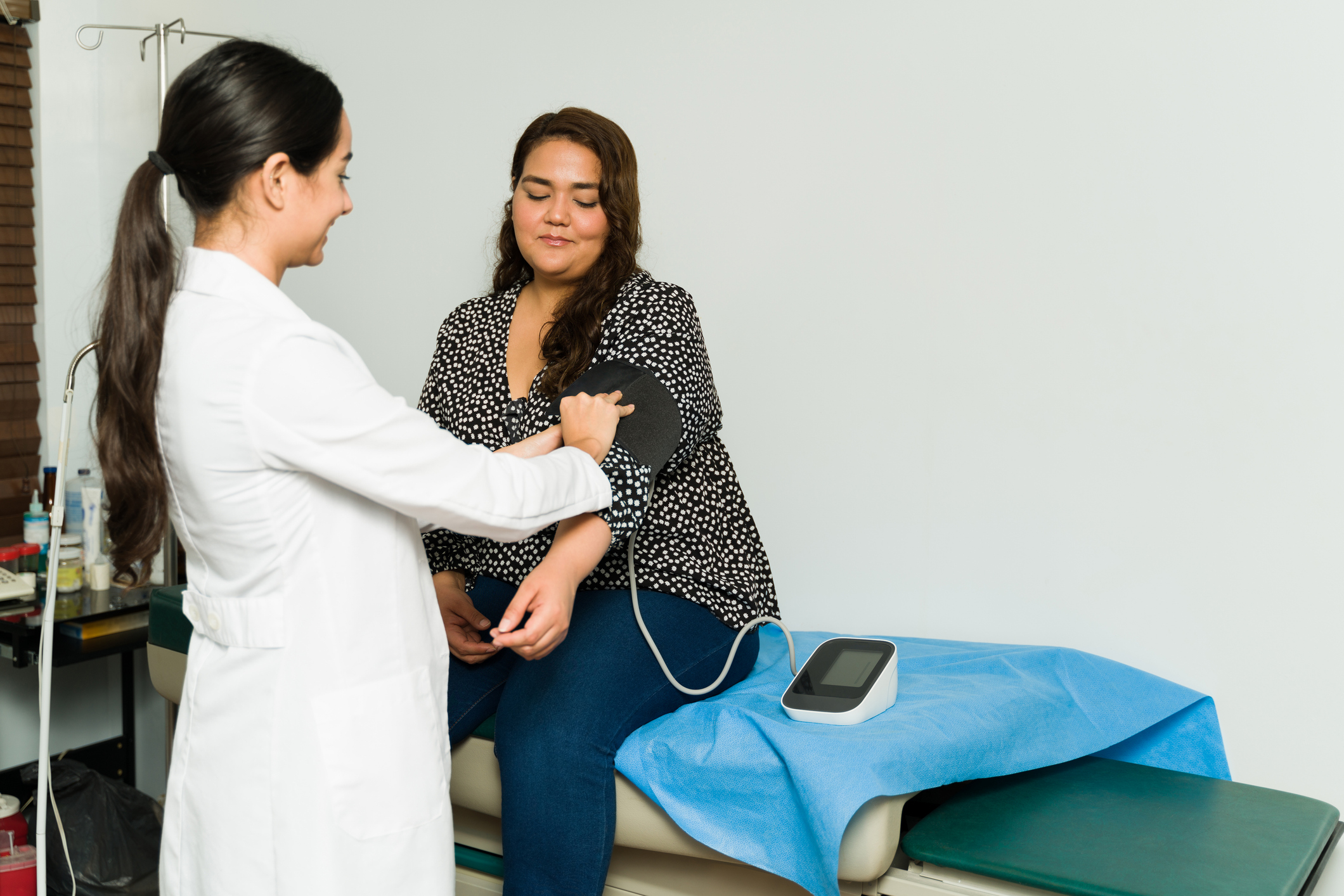
Medi-Cal on the Chopping Block: Key Facts About Medi-Cal Beneficiaries
Introduction
Medicaid is a federal program jointly administered and financed with state governments that provides health care coverage for children, low-income individuals, older adults in need of long-term care, and individuals with disabilities. Medi-Cal, California’s state Medicaid program, serves over 14 million people and provides health care coverage to about one-third of the state population.1 While Medicaid is a federally funded program, states are given the flexibility to extend coverage to certain optional groups. For example, California is one of 41 states2 that have expanded the income eligibility to 138% of the Federal Poverty Level (FPL) under the Affordable Care Act (ACA). Additionally, using state funds, California expanded Medi-Cal to cover certain qualifying low-income individuals regardless of immigration status.3
In 2023, the federal government provided $90 billion in funding for Medi-Cal, which made up two-thirds (67%) of the program’s funding.4 With looming threats of federal Medicaid cuts, California could be forced to impose work requirements,5 restrict eligibility, and roll back critical benefits, such as dental, vision, and other preventive services, putting millions at risk.6 Cuts would affect 43% of all children younger than 18, 23% of working-age adults (ages 18 to 64), 22% of seniors, and disproportionately affect Latino enrollees.7
Using enrollment data from California’s Department of Health Care Services, demographic data from the Census Bureau’s American Community Survey, and health outcome data from the California Health Interview Survey,8 this data brief provides key facts on Medi-Cal beneficiaries and underscores the broader community and economic implications of reductions to Medicaid funding.
Key Findings
Key Finding 1. Cuts to Medi-Cal would disproportionately harm Latino communities.
More than half (52%) of Medi-Cal enrollees in California are Latino (Figure 1), notably greater than the Latino share of the total state population (40%).9 The share of Latino enrollees is also 36 percentage points greater than that of white enrollees (16%), the second-largest racial group enrolled in Medi-Cal.
Figure 1. Medi-Cal Enrollees in California by Race and Ethnicity, August 2024
Note: Non-Latino groups only include non-Hispanic individuals.
Source: LPPI analysis of the California Department of Health Care Services Medi-Cal Certified Eligibles Data by Month with Demographics, August 2024.
Key Finding 2. Latino Medi-Cal beneficiaries participate in the labor force at higher rates than other racial and ethnic groups, however, a Medicaid work requirement could lead to millions losing coverage (see Figure 2).
Around 63% of Latino working-age (18-64) California Medi-Cal enrollees participate in the labor force, meaning they are either employed or job hunting, compared to 55% of white enrollees and 60% of Asian or Pacific Islanders (AAPI) enrollees. However, this still indicates that work requirements for Medicaid could result in 2.3 million or 40% of all current enrollees losing coverage, and over half of these individuals are Latino. Research shows that work requirements do not meaningfully increase employment or earnings.10 Instead, they take vital resources away from families by adding unnecessary paperwork burdens, and are tied to deeper levels of poverty.11
Figure 2. Labor Force Participation Rates among Civilian Working-Age (18-64) Medi-Cal Beneficiaries by Race and Ethnicity, 2023
Notes: Data reflect civilian workers ages 18 to 64 who self-reported Medicaid coverage. Non-Latino groups only include non-Hispanic individuals. Estimates are rounded to the nearest 1,000. Data on Medi-Cal enrollment from the American Community Survey tend to be lower than the administrative source.
Source: LPPI analysis of data from the Census Bureau’s American Community Survey 2023 1-year Estimates.
Key Finding 3. A Medicaid work requirement would disproportionately impact U.S.-born beneficiaries, who have lower labor force participation rates than immigrant enrollees across all racial and ethnic groups.
Among naturalized citizens, multiracial individuals have the highest rates of labor force participation (72%), followed by Latinos (63%). Furthermore, noncitizen Latino beneficiaries have the highest rate of labor force participation (66%) compared to other racial and ethnic groups.
Figure 3. Labor Force Participation among Civilian Working-Age (18-64) Medi-Cal Beneficiaries by Race, Ethnicity, and Citizenship, 2023
Notes: Data reflect civilian workers ages 18 to 64 who self-reported Medicaid coverage. Non-Latino groups only include non-Hispanic individuals. Data for “Native American” and “Other” race individuals who are naturalized citizens or noncitizens are unavailable due to small sample sizes. Data for noncitizens includes individuals residing in the U.S. who were not U.S. citizens at birth and were not naturalized U.S. citizens at the time of the survey. Data on Medi-Cal enrollment from the American Community Survey tend to be lower than the administrative source.
Source: LPPI analysis of data from the Census Bureau’s American Community Survey 2023 1-year Estimates.
Key Finding 4. Over 1.4 million Latinos enrolled in Medi-Cal are employed in high-need industries essential to the state’s economy.
The top five industries with the largest share of Latino enrollees are: hospitality (16%), health care (15%), retail (14%), professional (11%), and construction (9%; see Figure 4). These workers often are in low-wage positions with variable hours and lack access to employer-sponsored insurance, making Medi-Cal a critical source of coverage for these industries.12
Figure 4. Employed Latino Civilian Working-Age (18-64) Medi-Cal Beneficiaries by Industry, 2023
Notes: Data reflect employed Latino civilian workers ages 18 to 64 who self-reported Medicaid coverage. Estimates are rounded to the nearest 1,000. Data on Medi-Cal enrollment from the American Community Survey tend to be lower than the administrative source.
Source: LPPI analysis of data from the Census Bureau’s American Community Survey 2023 1-year Estimates.
Key Finding 5. Medi-Cal is a lifeline for our children and youth, especially for Latino families.
Among Latino enrollees, 38% are children (ages 0-18), four percentage points higher than the total share of child enrollees across the state (34%; see Figure 5). The median age of Latino beneficiaries is 25 years old, compared to 49 years of white enrollees, 46 years of AAPI enrollees, and 39 years of Black enrollees,13 making the program critical to the health and development of California Latino youth and young adults. Lastly, Medi-Cal plays a crucial role in maternal health, covering 39% of all births in the state.14
Figure 5. Share of Children (0-18) Enrolled in Medi-Cal by Race and Ethnicity, August 2024
Note: Non-Latino groups only include non-Hispanic individuals.
Source: LPPI analysis of the California Department of Health Care Services Medi-Cal Certified Eligibles Data by Month with Demographics, August 2024.
Key Finding 6. Medi-Cal is vital for aging with dignity, regardless of race or income.
Medicare does not cover most long-term care services, such as extended stays in nursing homes or home-based caregiving that helps preserve autonomy and quality of life. For many low-income seniors, Medi-Cal is the only way to afford this crucial long-term care that helps them age with dignity. Among seniors with Medi-Cal coverage, about 1.4 million were also covered by Medicare, and almost 451,000 are Latino (Figure 6). More than a third (35%) of Latino seniors with Medicare are also covered by Medi-Cal, a rate equivalent to AAPI, Black, and Native American seniors, albeit much higher than white seniors.
Figure 6. Share of Medi-Cal and Medicare Dual Enrollees (Ages 65 and over) in California by Race and Ethnicity, 2023
Notes: Non-Latino groups only include non-Hispanic individuals. Estimates are rounded to the nearest 1,000. Data on Medi-Cal enrollment from the American Community Survey tend to be lower than the administrative source.
Source: LPPI analysis of data from the Census Bureau’s American Community Survey 2023 1-year Estimates.
Key Finding 7. Medi-Cal provides a crucial and consistent source of health care for adults managing chronic health conditions, regardless of race or ethnicity.
Medi-Cal is especially important in the management of diabetes and other chronic conditions among low-income adults, as they are disproportionately affected by the disease and are more likely to develop diabetes-related complications.15 About 16% of all adult (ages 18 and older) enrollees have been diagnosed with diabetes compared to 11% of the general population (Figure 7). Latino and Black enrollees also experience the highest rates of diabetes (18%) compared to other racial and ethnic groups.
Figure 7. Age-Adjusted Prevalence of Diabetes among California Adults (18+) by Race and Ethnicity, 2023
Notes: This question was only asked of adults ages 18 and older. Non-Latino groups only include non-Hispanic individuals. To calculate age-adjusted rates, we used the statewide age distribution from the American Community Survey 2023 5-year Estimates as the standardized population.
Source: LPPI analysis of AskCHIS 2019-2023, Ever diagnosed with diabetes (California), and the Census Bureau’s American Community Survey 2023 5-year Estimates.
Key Finding 8. Cuts to Medicaid would disproportionately impact not only the counties and congressional districts with large Latino working-class populations but also those that are politically and economically pivotal to California’s future.
- Los Angeles County alone has 2.4 million Latino Medi-Cal beneficiaries. Latino enrollees represent 60% of all Medi-Cal enrollees in the county. LA County spans 17 congressional districts, including CA-29, CA-34, and CA-42.16
- The Inland Empire (Riverside and San Bernardino Counties) serves over 1.1 million Latino Medi-Cal recipients in districts like CA-25 and CA-35.
- Central Valley counties—Fresno, Kern, and Tulare—have the highest Latino enrollment shares, up to 73%, overlapping with agricultural districts CA-20, CA-21, and CA-22.
- Santa Clara and Alameda Counties together serve nearly 375,000 Latino enrollees, concentrated in innovation regions like CA-16, CA-17, and CA-18.
- Orange and San Diego Counties account for over 900,000 Latino enrollees combined, affecting suburban districts like CA-45, CA-46, CA-49, and CA-52.
Figure 8. Latino Share of Medi-Cal Beneficiaries by County, August 2024
Source: LPPI analysis of the California Department of Health Care Services Medi-Cal Certified Eligibles Data by Month with Demographics, August 2024.
Figure 9. Latino Share of Medi-Cal Beneficiaries by Congressional District, 2023
Source: LPPI analysis of data from the Census Bureau’s American Community Survey 2023 5-year Estimates. The congressional district allocation is generated using the Geocorr 2022 from Census blocks to Public Use Microdata areas (PUMA) and Census blocks to the 119th Congressional Districts from the Missouri Census Data Center while controlling for the number of Latino/non-Latinos by congressional districts based on Census Bureau estimates.
Appendix
Appendix 1. Data Sources and Methodology
This brief draws on multiple data sources to analyze the impacts of cutting federal funding for Medi-Cal and examine the characteristics of Latino beneficiaries:
- Enrollment data were drawn from California’s Department of Health Care Services’ Medi-Cal Certified Eligibles Data by Month with Demographics resource. Enrollment data represent certified eligible counts or beneficiaries deemed qualified for Medi-Cal and who are enrolled in the program.17 Enrollment data are reported on a monthly basis. We analyze and present for August 2024, the most recent month for which data are publicly available.
- Data on labor force participation, employment, Medicare dual enrollees, and congressional district-level Medi-Cal coverage were derived from the Census Bureau’s American Community Survey (ACS) 2023 1-year and 5-year Estimates.
- Data on the prevalence of diabetes were obtained from the California Health Interview Survey (CHIS) from 2019 to 2023. We report age-adjusted estimates for rates of diabetes to account for the effects of age differences on health outcomes.17 To calculate age-adjusted rates, we used the statewide age distribution from the 2023 5-Year ACS as the standardized population.
Appendix 2. Table 1. Latino Share of Medi-Cal Beneficiaries by County, August 2024
Source: LPPI analysis of the California Department of Health Care Services Medi-Cal Certified Eligibles Data by Month with Demographics, August 2024.
Appendix 3. Table 2. Latino Share of Medi-Cal Beneficiaries by the 119th Congressional District, 2023
Note: Data on Medi-Cal enrollment from the American Community Survey tend to be lower than the administrative source.
Source: LPPI analysis of data from the Census Bureau’s American Community Survey 2023 5-year Estimates. The congressional district allocation is generated using the Geocorr 2022 from Census blocks to Public Use Microdata areas (PUMA) and Census blocks to the 119th Congressional Districts from the Missouri Census Data Center while controlling for the number of Latino/non-Latinos by congressional districts based on Census Bureau estimates.
References
1Legislative Analyst’s Office, The California Legislature’s Nonpartisan Fiscal and Policy Advisor, “The 2024-25 Budget: Medi-Cal Fiscal Outlook,” (December, 2023), available online.
2Kaiser Family Foundation (KFF), “Status of Medicaid Expansion Decisions,” April 17, 2025, available online.
3 California Health Care Foundation (CHCF), “Medi-Cal Fast Facts and Figures: Essential Source of Coverage for Millions,” (June 2024), available online.
4 LPPI calculations based on the National Association of State Budget Officers State Expenditure data, available online.
5 Elizabeth Hinton and Robin Rudowitz, “5 Key Facts About Medicaid Work Requirements,” KFF, February 18, 2025, available online.
6 Liz Seegert, “Looming budget cuts: What to know when covering Medicaid for older adults,” Association of Health Care Journalists, April 3, 2025, available online.
7 LPPI analysis of data from the Census Bureau’s American Community Survey 2023 1-year Estimates.
8 For data and technical information, see Appendix 1.
9 Latino Data Hub, “Percent of the Total Population in California, 2022,” Accessed April 16, 2025, available online.
10 Congressional Budget Office, “Estimate of the Budgetary Effects of H.R. 2811, the Limit, Save, Grow Act of 2023,” April 25, 2023, available online.
11 Alissa Anderson, Adriana Ramos-Yamamoto, and Monica Saucedo, “Paperwork Over People: Why Republican “Work Requirements” Fail Families,” California Budget & Policy Center, March 2025, available online.
12 Akeiisa Coleman and Sara Federman, “Work Requirements for Medicaid Enrollees,” The Common Wealth Fund, January 14, 2025, available online.
13 LPPI analysis of data from the Census Bureau’s American Community Survey 2023 1-year Estimates.
14 CHCF, “Medi-Cal Facts and Figures: Essential Source of Coverage for Millions.”
15 Boon Peng Ng, Sundar S. Shrestha, Andrew Lanza, Bryce Smith, Ping Zhang, “Medical Expenditures Associated With Diabetes Among Adult Medicaid Enrollees in Eight States,” Centers for Disease Control and Prevention (CDC), September 27, 2018, available online.
16 Secretary of State, “Political Subdivisions by County,” Elections Division California Official Statewide Voter Registration System (VoteCal), March 5, 2024, available online.
17 Department of Health Care Services, “Fast Facts,”Accessed April 16, 2025, available online.
18 Missouri Department of Health and Senior Services, “Age-Adjusted Rate Definitions,” Accessed April 16, 2025, available online.













